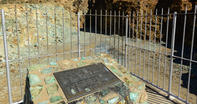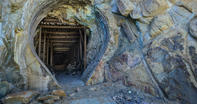The Blue Mine
The ‘Blue Mine’ at Springbokfontein, which had been controversially purchased by Phillips and King, began producing considerable quantities of copper ore, which were transported by ox-wagon over the mountains to Hondeklip Bay.

A German named Von Schlicht, who originally found the copper seam, was well and truly trumped, but he didn’t give up and set about prospecting around the area to try and find another windfall. Within a few months, he did indeed identify several additional copper deposits, but these were located on crown lands and not private farms.
Reluctantly, he applied to the government for the mining rights to these lands, but the government wasn’t about to be duped again. This time, they made a public announcement (in 1853) that the mineral rights to various portions of crown land in Namaqualand would be leased to any interested parties.
The Copper Bonanza

Of course, the city of Cape Town went bananas as news of the copper bonanza spread. It was said ‘that the copper mines of Namaqualand extend, almost without interruption, over a surface of from 8000 to 9000 square miles, at all degrees of depth, and that the ore is found almost everywhere at the surface’.
Several prominent surveyors and geologists (including the redoubtable A.G. Bain) went to visit the area and sent back optimistic reports. Suddenly, everyone wanted to get in on the action. It was a copper rush! Spurred on by such stories of copper lying on the ground, people scrambled to buy leases on ‘centres’ of land.
These were defined as pieces of land no less than 10 and no more than 40 morgen to be leased at a rate of £1 per morgen per year, payable in advance. A diagram of the claim had to be lodged within 12 months, during which time the applicant had the opportunity to search within a radius of one mile from the central point described in the lease to identify the best spot for mining. Grazing rights were also included.
By David Fleminger